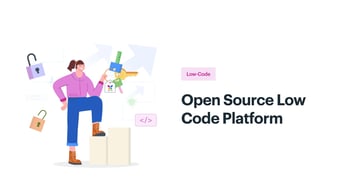
- >
- Low code>
- Application modernization>
- Enterprise Application Modernization: Why Your Legacy Systems Are Costing You More Than You Think
Enterprise Application Modernization: Why Your Legacy Systems Are Costing You More Than You Think
Your enterprise applications were built for a different era. Back when on-premise servers were the gold standard, monolithic architectures were the norm, and business moved at a predictable pace. But that was then.
Today, your competitors are launching features in days, not months. They're scaling operations without breaking a sweat. And while you're stuck troubleshooting integration issues with a 15-year-old system, they're already capturing market share you didn't even know was up for grabs.
The hard truth? 79 percent of modernization projects encounter failures, with each failed attempt costing organizations around $1.5 million and taking up to 16 months to resolve. But here's what separates market leaders from the rest: they don't avoid legacy systems. They strategically modernize them.
Learn more: Benefits of Low-Code Platform for Modernizing Legacy Systems
What enterprise application modernization really means
Let's cut through the technical jargon. Enterprise application modernization isn't about chasing the latest tech trends or rebuilding everything from scratch because it sounds exciting. It's a strategic process of updating your existing software systems to meet current business demands while improving performance, security, and scalability.
Think of it this way: you wouldn't try to compete in Formula 1 with a vintage car, no matter how well-maintained it is. The same logic applies to your business applications. Your legacy systems might still "work," but they're holding you back from the speed and agility your business needs to thrive.
Business application modernization typically involves migrating to cloud infrastructure, adopting microservices architecture, refactoring outdated code, and integrating modern development practices. But the real goal isn't just technical improvement. It's about positioning your business to respond faster to market changes, reduce operational costs, and create better experiences for your customers and employees.
The real cost of standing still
Let's talk numbers. The global enterprise application market was valued at $320.40 billion in 2024 and is projected to reach $625.66 billion by 2030, growing at an 11.8 percent CAGR. Organizations that fail to modernize aren't just missing out on this growth. They're actively losing ground.
Your legacy systems are bleeding your budget in ways you might not immediately see. There's the obvious stuff like maintenance costs that keep climbing as finding developers who know COBOL or outdated frameworks becomes harder. But there's also the hidden tax: slower time-to-market, inability to integrate with modern tools, security vulnerabilities that put your entire operation at risk, and the opportunity cost of not being able to pursue new business models.
Learn more: What is Technical Debt: complete guide for business leaders and IT teams
92 percent of enterprises are currently working on modernization projects, and there's a reason for that urgency. In a recent survey, 68 percent of respondents identified improving CI/CD pipelines as their top definition of application modernization. This marks a significant shift from just a few years ago and underscores how fundamental software development practices are being transformed.
The companies winning in their markets right now? They've already made the investment. They're operating on cloud-native platforms that scale effortlessly, deploying updates continuously without downtime, and using data analytics that actually provide actionable insights instead of just generating reports no one reads.
What's driving the modernization imperative
Three factors consistently top the list when IT leaders explain why they're modernizing: security, reliability, and scalability. And they're seeing results. 58 percent of organizations have already experienced security benefits from their modernization efforts, while 52 percent report improved reliability and 53 percent see better scalability.
But there's another driver that's harder to quantify but equally important: competitive pressure. Your industry is being disrupted, whether you see it happening or not. The question isn't whether you need to modernize. It's whether you'll do it proactively or be forced into it when a competitor makes your current offering obsolete.
Consider this: applications over a decade old were likely built with outdated technology and lack the flexibility modern businesses require. They struggle with integration, can't support modern workflows, and limit your ability to adopt emerging technologies like advanced analytics or automation tools
Learn more: Top 10 low-code business challanges Can Solve
Where to focus your modernization efforts
Not every application needs the same approach. The "7 Rs" framework, popularized by AWS, offers a practical way to evaluate what modernization strategy makes sense for each system:
- Rehost moves your applications to new infrastructure with minimal code changes. It's fast and low-risk, but you don't get the full benefits of modern architecture.
- Replatform takes things a step further, making small optimizations during migration. You're still not reinventing the wheel, but you're getting better performance and cost efficiency.
- Refactor involves modifying your codebase to remove inefficiencies and improve maintainability. This is where you start seeing real improvements in how your applications perform and how easily your team can work with them.
- Rearchitect means redesigning your application structure entirely, often moving to microservices or serverless architectures. It's more complex but unlocks significantly more value.
- Rebuild starts from scratch with modern tools and architecture. It's the most resource-intensive option but sometimes necessary when legacy systems are beyond salvage.
The key is matching the right strategy to each application based on its business value, technical debt, and strategic importance. Your customer-facing applications that drive revenue? Those deserve more aggressive modernization. That internal tool that three people use once a quarter? Maybe rehosting is sufficient.

The Ultimate Beginner's Guide to Low-Code
Thank you for Downloading
Learn more: How to build Custom Logistics Management SoftwareUsing Low-Code Platform
The path forward
Here's what smart modernization looks like: you start with a thorough audit of your current application portfolio. Not just cataloging what you have, but understanding the dependencies, integration points, business processes, and actual usage patterns.
Then you prioritize ruthlessly. Which applications are blocking your business goals? Where are you spending the most on maintenance? What systems pose the biggest security risks? Those go to the top of your list.
Next, you choose the right modernization approach for each application. This isn't one-size-fits-all. You might rehost some applications, refactor others, and rebuild a few from the ground up.
Throughout the process, you document everything. Architecture diagrams, code documentation, progress reports. Documentation at the enterprise level, where many people are performing different tasks simultaneously, is key to success. This isn't bureaucracy. It's how you prevent chaos when you're modernizing at scale.
You also need to establish clear KPIs. How will you measure success? Uptime percentages? Deployment frequency? Cost savings? User satisfaction scores? Define these early so you can track progress and prove ROI.
The modernization accelerator you might be overlooking
While many organizations focus solely on choosing between custom development or off-the-shelf solutions, there's a middle path that's gaining traction: platforms that balance speed with flexibility.
This is where Kissflow's capabilities become relevant. The platform's workflow automation and process management features let you modernize how work gets done without requiring your entire IT team to become full-stack developers. You can map complex business processes visually, automate approval workflows that are currently trapped in email chains, and integrate systems that were never designed to talk to each other.
What makes this approach practical for enterprise app modernization is that you're not forced into an all-or-nothing choice. You can use process automation to quickly modernize specific workflows while your IT team tackles more complex architectural changes. The visual development environment means business analysts can contribute directly to modernization efforts instead of everything bottlenecking through your development team.
For organizations dealing with the reality of modernization timelines (remember, the average project takes 16 months), having tools that accelerate specific parts of your modernization journey can be the difference between staying on schedule and watching your project slip into year two.
FAQ's - Entprise Application Modernization
1. What is enterprise application modernization?
Enterprise application modernization is the process of updating legacy systems to current technologies, architectures, and development approaches. It involves transforming outdated applications to improve performance, reduce maintenance costs, enable cloud deployment, enhance user experience, and integrate with modern software ecosystems. Modernization can range from minor updates to complete rebuilds.
2. How to modernize legacy applications for digital transformation
Start by assessing your application portfolio to identify which systems create the most business value or technical debt. Choose a modernization approach: refactor, replatform, replace, or retire. Prioritize applications that block digital initiatives or consume excessive maintenance resources. Use low-code platforms to rebuild business logic quickly. Implement APIs to connect legacy systems temporarily. Migrate to cloud infrastructure for scalability. Execute in phases to minimize disruption.
3. What are application modernization strategies for CIOs 2025
Leading strategies include cloud-first architecture, API-driven integration, microservices decomposition, low-code rebuilds for business applications, containerization for portability, and data modernization alongside application updates. CIOs are prioritizing AI-ready architectures, real-time data access, mobile-first experiences, and composable applications that can adapt quickly. The focus has shifted from "lift and shift" to fundamental reimagining of how applications serve business needs.
4. What are the benefits of modernizing legacy enterprise systems
Modernization reduces maintenance costs by 40-60%, improves application performance and reliability, enables faster feature development, enhances security and compliance, facilitates cloud migration, improves user satisfaction, reduces technical debt, enables better data analytics, supports mobile and remote work, and frees IT resources for innovation. Modern systems also integrate more easily with new technologies like AI and automation.
5. What are the steps to modernize enterprise applications successfully
First, inventory and assess all applications for business value and technical health. Define clear business objectives and success metrics. Choose the right modernization approach for each application. Secure executive sponsorship and adequate budget. Build a cross-functional team including business stakeholders. Start with a pilot project to prove value. Create a phased roadmap prioritizing high-impact applications. Establish governance for architecture decisions. Plan for data migration and integration. Train users early and often. Monitor results and adjust your approach.
6. How low-code accelerates application modernization
Low-code reduces development time by 50-70% through visual development, pre-built components, and automatic code generation. Teams can rebuild legacy functionality rapidly without rewriting thousands of lines of code. Business users can participate directly in defining requirements through working prototypes. Integration connectors handle common legacy system connections. The visual nature makes applications easier to maintain and modify as business needs evolve.
7. What are some of the enterprise application modernization challenges and solutions
Common challenges include unclear business requirements (solution: involve stakeholders early), data migration complexity (solution: phase migrations and validate thoroughly), integration with remaining legacy systems (solution: API layer strategy), user resistance (solution: change management and training), budget constraints (solution: phased approach with quick wins), skills gaps (solution: low-code platforms and training), and maintaining operations during transition (solution: parallel running and careful cutover planning).
8. What are some of modernization tools and platforms for IT leaders
Key tools include low-code platforms like Kissflow for rapid application rebuilds, cloud platforms like AWS and Azure for infrastructure, containerization tools like Docker and Kubernetes for portability, API management platforms for integration, automated testing tools for quality assurance, and application portfolio management tools for planning. The right mix depends on your existing technology stack, skills availability, and modernization goals.
9. How to reduce technical debt through modernization
Reduce technical debt by retiring unused applications, consolidating redundant systems, refactoring poorly structured code, updating outdated frameworks and libraries, documenting undocumented systems, automating manual processes, implementing proper testing, establishing coding standards, and creating regular maintenance schedules. Use modernization as an opportunity to establish better development practices that prevent future debt accumulation.
10. Best practices for enterprise application modernization
Start with business outcomes, not technology. Assess before acting. Involve business stakeholders throughout. Take a portfolio approach rather than application-by-application. Begin with high-value, lower-risk applications. Use agile methods for flexibility. Plan for data quality and migration. Establish clear governance and standards. Invest in change management and training. Build APIs for integration. Measure and communicate progress. Celebrate wins to maintain momentum. Keep security and compliance central to all decisions.
Start your modernization journey with a platform that accelerates transformation.
Related Articles











